
I’ve reached the end of my summer reading pile (yes, still got a PhD to assess, and reviewing and …). As I read, I tag papers and sources that have candidate diagrams for this collection. On revisiting, only about half of those get included. I have changed the criteria a bit, I used to be strict – diagrams had to explicitly be a visual definition of sustainability, but now I’m happy if it adds to understanding of sustainability (or raises questions), sometimes even if through an exploration of unsustainability. I’m still trying to avoid implications of sustainability – how to build a passive house and so on. But there’s an increasingly grey line here, especially in the management and education literature – a diagram of sustainable competencies in effect defines sustainability. I’m about halfway through the candidate pile, hoping to get it done before I go back to work. But as the milestone of 1000 images seems important, I’m uploading now. Also, there’s a beach to go swim at.
901. Four Urban Futures (Lombardi via Mykhnenko 2023)

902. All the things (Graphical abstract from Ramakrishna 2022)

903. Six relationships (six wayfinder)

904. Capital Reproduction (Hautamäki 2010)

905. People-with-nature (González 2008)

906. Legacy (Schillebeeckx 2022)

907. Nature Tech (Schillebeeckx 2022)
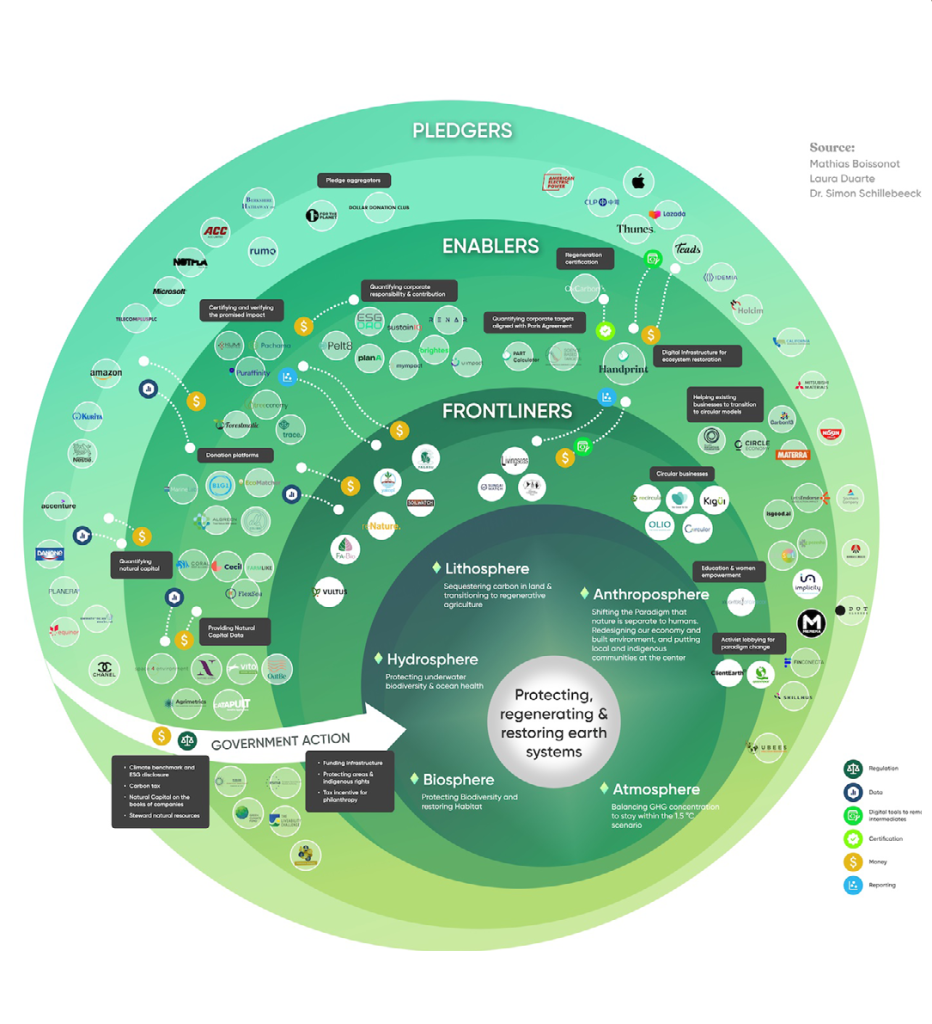
908. Sustainable Rubik’s Cube – Setup (Liu 2020)

909. Sustainable Rubik’s Cube – Magic (Liu 2020)
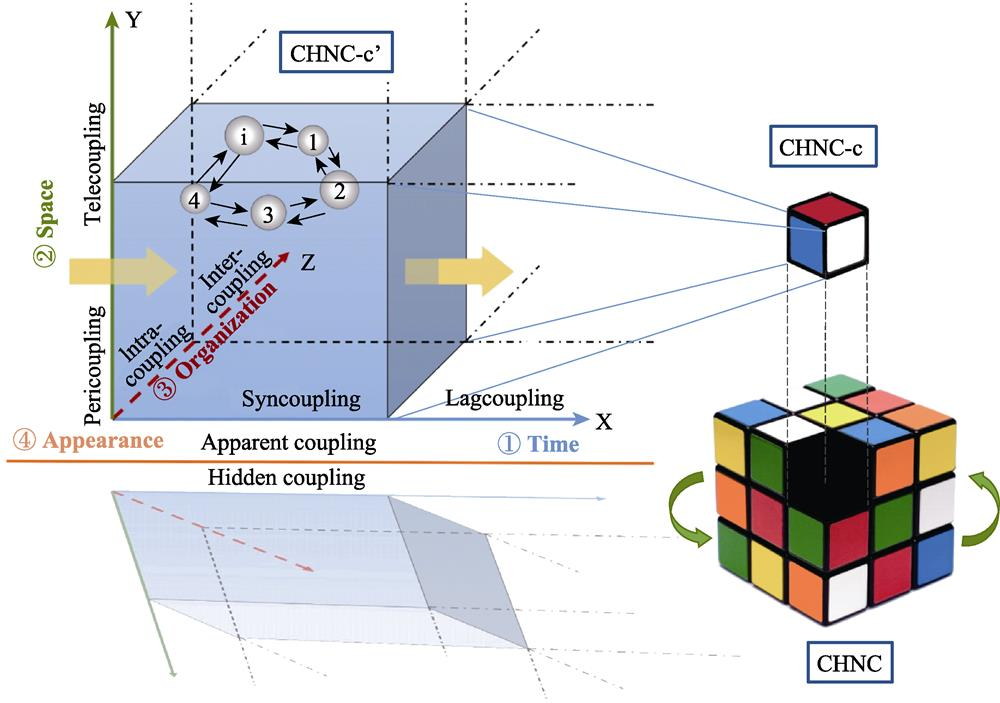
910. Sustainable Rubik’s Cube – Payoff (Liu 2020)

911. Coupling and a yin yang marble run (Sorry, I didn’t follow how to get from the cube to here, something about syncoupling and lagcoupling) (Liu 2020)

912. SOLA (Pieper 2019)

913. From triple-bottom-line to multienvironmental scanning. (I don’t know what it means either) (Roth 2020)

914. Salmon circles (Connors 2023)

Another version has mismatched puzzle peices

915. Desirable and meaningful in multidimensional social-ecological space (Leach 2018)

916. Equitable Sustainability (Leach 2018)

917. Health (Alvarez 2018 via sSahely)

918. Restorative Roots (Tedesco 2023)
(yes OK, a stretch to call this one sustainability, but i couldn’t seriously leave it out).

919. . Restoration as a holistic, iterative, social-ecological process (Tedesco 2023)

920. Noise without irritation (Integrating Sociological Risk Theory) (Peter 2020)

921. Grid-group typology (Peter 2020)

922. God, Perfect Human, Nature, Materialistic Human. Got it. (Taghvaee 2017)

923. Technology spiraling out of control (Bakshi 2017)
“methods must satisfy to guide technological development toward sustainability is still quite limited”

924. Dialectic (Fuchs 2017)
I argue for a third model (M3) that is a further development of M2. It besides the economy also foregrounds the political and the cultural system as parts of society and is based on a dialectic of nature/society and a dialectic of the economy/the non-economic (the political and the cultural). In model M3, society is made up of the economy, politics and culture and these 3 interacting realms of society are grounded in nature, with which society interacts.

925. Dialectic of dynamically reproducing subsystems (Fuchs 2017)

926. Critical Sustainabilitiy Studies (Ferreria)

927. Sustainalism (Hariram 2023)


928. Harmony (Chen 2021)

929. Pillars, meet knowledge. Knowledge, Pillars. (Sabau 2010)

930. Unifying the opposites (The Eristic-Dialectical model of sustainable conflict resolution) (Ganoulis 2023)

931. Dialectical tensions (Rice 2022)

revised to promote communication
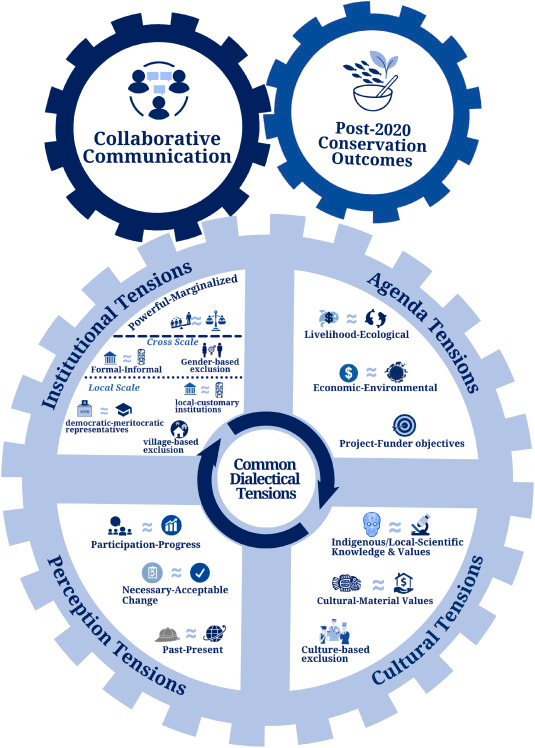
932. Nature based solutions (Palomo 2021)

933. Alluvial flow connecting cultural ecosystem services and well-being (Huynh 2022)
(flows represent frequency of these connections in literature)

934. Telecoupled (Liu 2013)

935. Gandhi’s “square of swaraj” into a sustainability cube (Saravanamuthu 2017)
Saravanamuthu translates Gandhi’s “square of swaraj” into her sustainability cube. Her cube explains how the swaraj methodology informs Risk Society’s journey toward sustainability amidst complexity, uncertainty, and diffused responsibility.
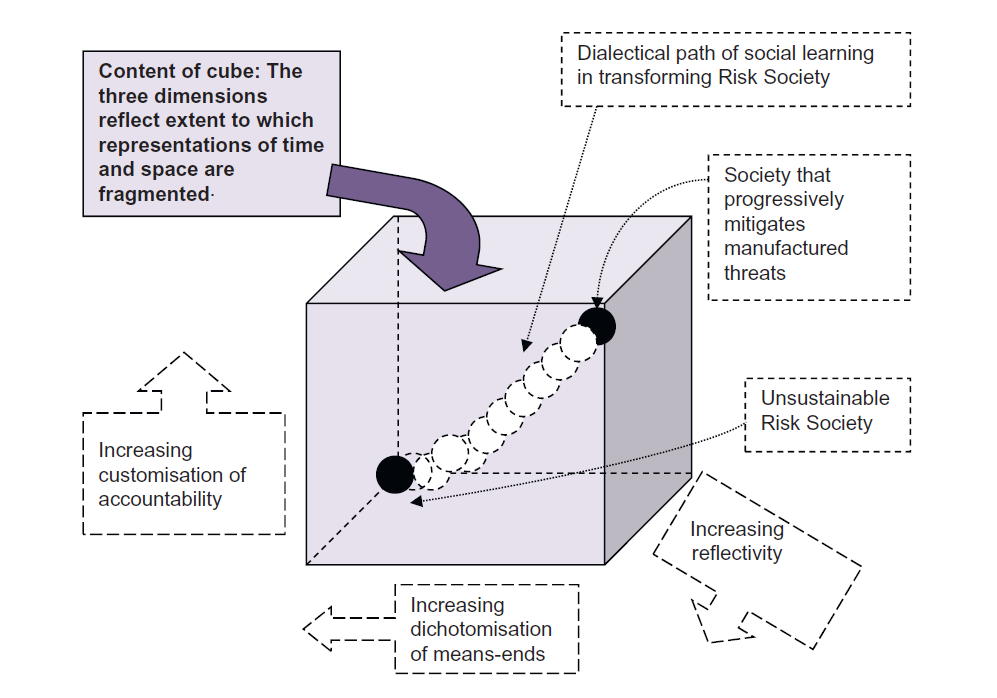
936. Tika Transitition (Bargh 2023)

937. Landscape Sustainability (Musacchio 2011)
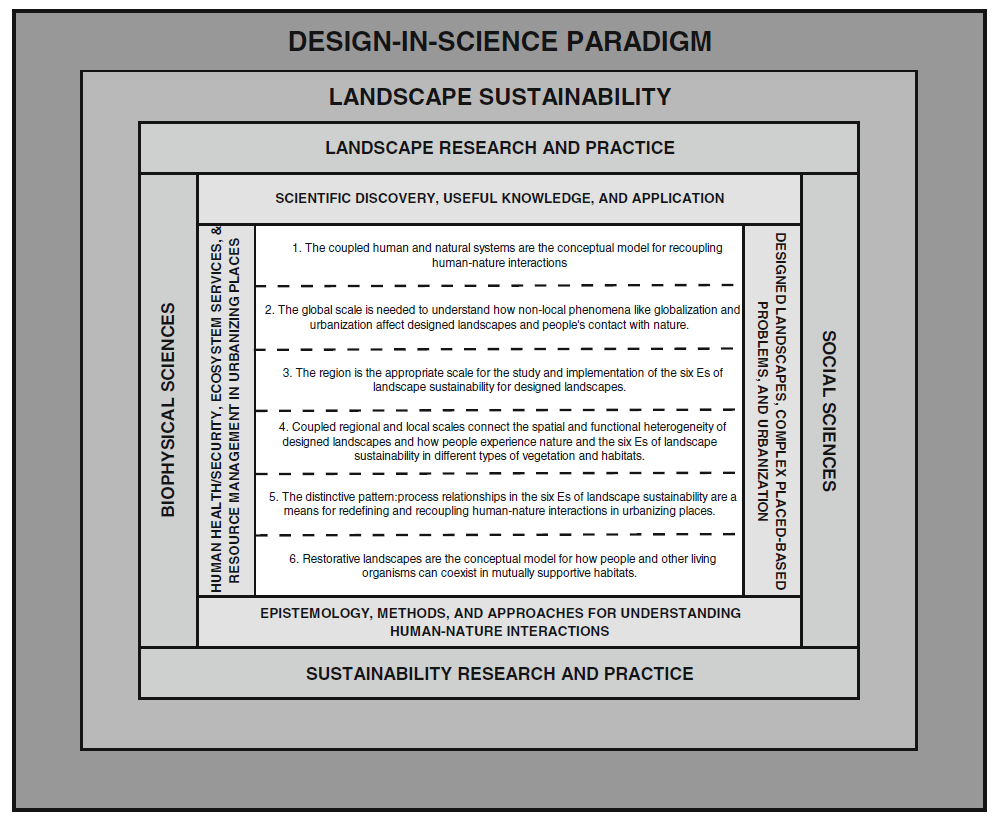
Six Es of landscape sustainability

938. Role of urbanisation as key driver in un/sustainability (Wu 2014)

939. Sustainability in Communal Socio-Ecological Systems (McHale 2013)

940. Focal-scale system change and environmental justice claim-making (Xu 2021)

941. Phases of change (Hagen 2013)

942. Designed or tipped (Brunckhorst 2023)
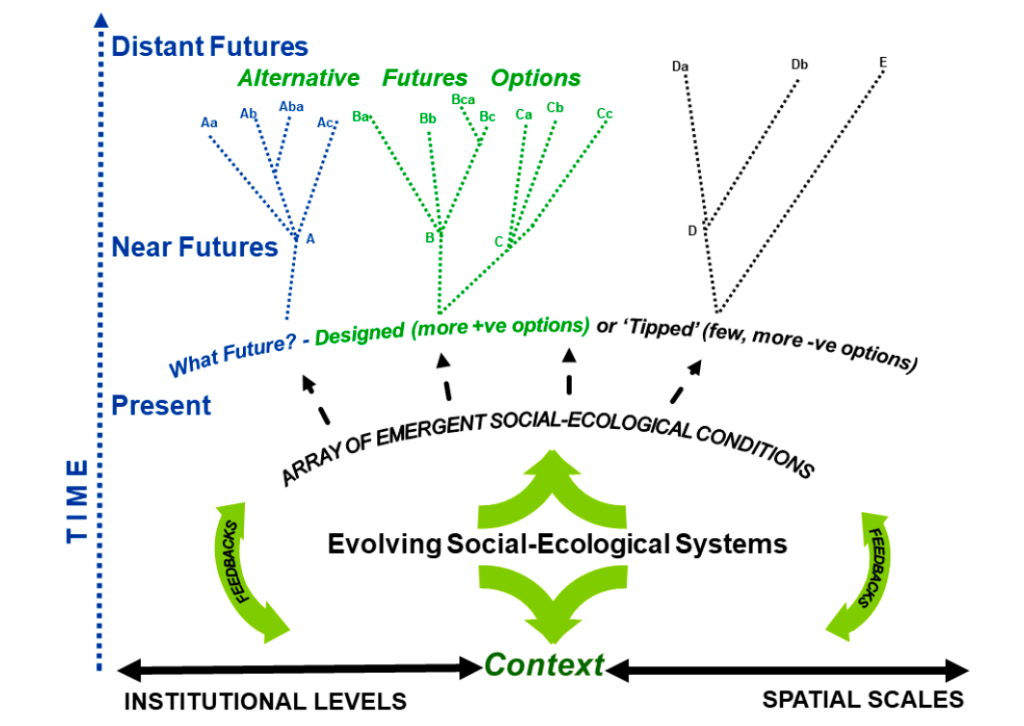
943. Landscape Loopholes (Brunckhosrt 2005)

944. Daly’s (and Meadows’) triangle (Wu 2018)

945. Landscapes (Wu 2018)

946. Fair, Scaled, Efficient (Ulman 2022)

947. Knotted paradox of coopetition (Manzhynski 2023)

949. Literacies (Göpel 2016)

950. Materiality of old ideas (Göpel 2016)

951. Why mainstream economics fails sustainability (Göpel 2016)

952. New paradigm of well-being and happiness (Bhutan NDP Steering Committee 2013 via Göpel 2016)

953. Typology of business change (Jablonski 2016)

954. Quality multifunctional capitals (Mino 2016)

955. Practices across scales and dimensions (Bejtullahu & Morishita-Steffen 2021)


956. Snuitroinamenπl (Ariza-Colpas 2023)
(no explanation in text for strange spellings. Variables for sustainable cultural tourism through augmented reality).

957. Normative landscape is not a subset of space alone (Berr 2023)

958. Conceptual world apprehension (Berr 2023)

959. Pedagogy of entanglement (Wessels 2022)

960. Closed loops in autotrophic organism (vs heterotrophic organism). (Rizzetto and Hooimeijer 2022)

961. Beyond closed loops (Rizzetto and Hooimeijer 2022)
962. System aliveness principles (Kuenkel 2019, Kuenkel & Ragnarsdottir 2022)




963. Sad planet, happy planet (Ragnarsdottir 2022)

964. Sustainability Gap (Nnoli-Edozien 2022)
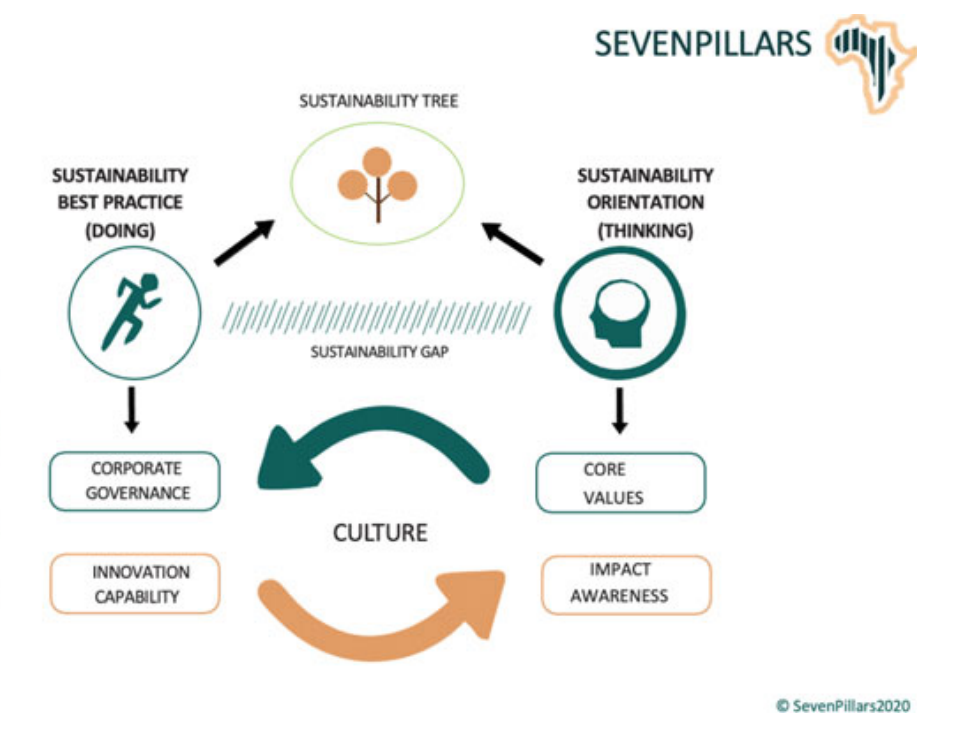
965. All Change! (Wamsler 2021)

966. Leadership transformation for sustainability (Wamsler 2024)
They involve: 1) how we see the world, 2) how we get to know, 3) how we engage, and 4) how we ensure quality and equity considerations across all aspects. Together, they support flourishing across scales—by covering all key contributions of inner-outer transformation.

967. Ways we understand and ways we dwell (Rozzi 1999)
Reciprocal influences between evolutionary-ecological sciences and environmental ethics. (a) The ways in which humans understand the natural world (sciences) and dwell in it (environmental ethics) are intimately linked by reciprocal influences (broad gray arrows) that take place within two broader environments: the cultural world and the natural world. The short double arrows crossing the borders of each circle emphasize the openness of each domain to influences occurring among all domains. The arrowheads in each of the circles indicate the dynamic character of each domain. (b) This concept can be elaborated based on the case of Darwin’s evolutionary theory.

968. Science, technology, society, and a tape measure (Voulvoulis & Burgman 2019)

969. Intrinsic, Instrumental, Relational values (Chan 2016)
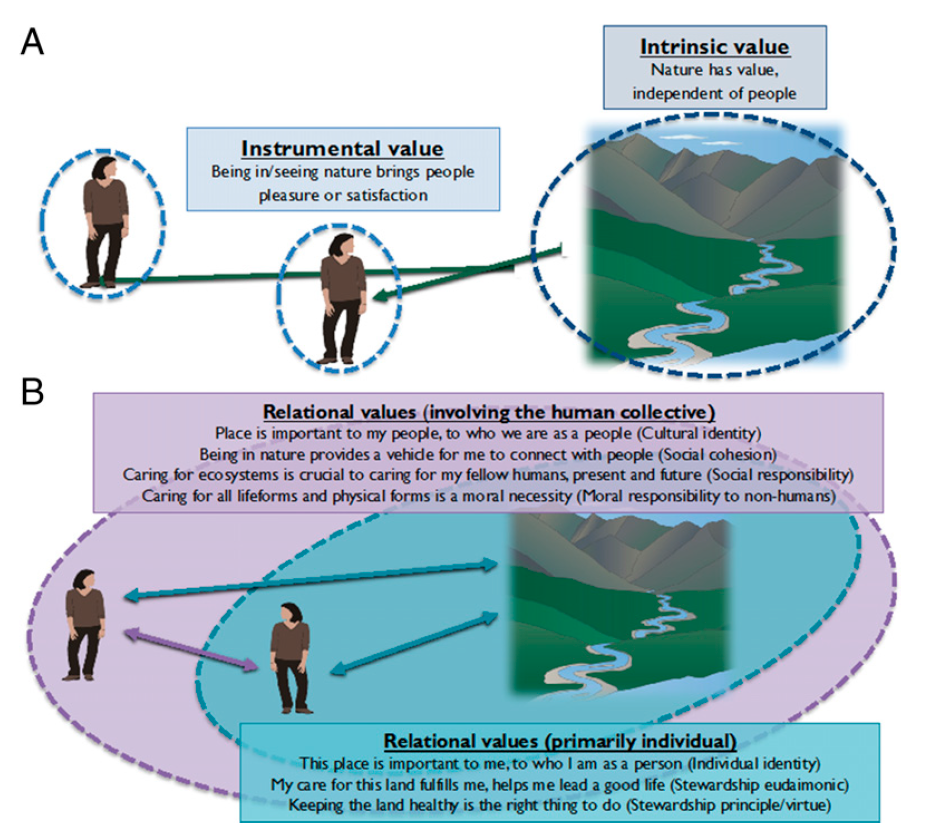
970. Human versus everybody and everything (including himself) (Wu 2023)
UAV = Unmanned Arial Vehicles

971. Sustainable diet dimensions (Parsons 2019)

972. 4Principles (Tavanti 2013)

973. Freedoms!! (Tavanti 2013)

974. Meetings and Claimings (Tavanti 2013)

975. -isms and -obias determining health. (Devakumar 2022).
I really like this representation, but it the focus is negative, would be fun to try turn it around.
(The Earth seems to have borrowed something from Saturn)

Cutaway version Deivanayagam 2023)

976. Living Standards, Contributions to People, and Living Standards again (Ausseil 2022)

977. Networks of resource ecologies (Narayan 2021)

977. Western life-world affected by social-ecological crisis (Artmann 2021)
(yes, another negative framing, but it sets up the next one)

978. Efficacious parterships (Artmann 2021)

979. Is it a diamond, is it a square? No, it’s a pentagon. (Tan 2023)

980. Actualised power in vanilla production (Neimark 2019)

981. Bottom-up view of subsistence farmers (Viswanathan 2014)

982. Relational (Helne 2015)
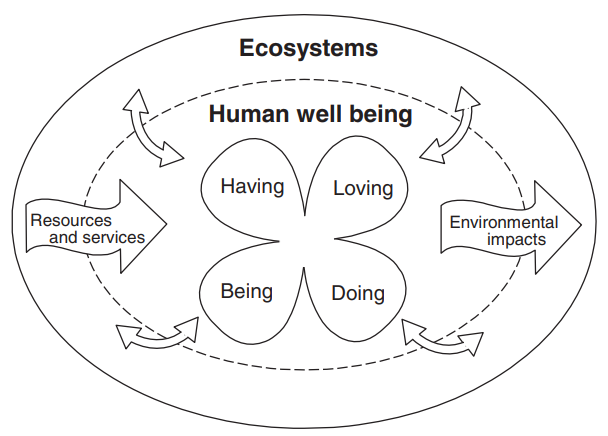
983. Relational leadership, ethic of care (Nicholson 2016)
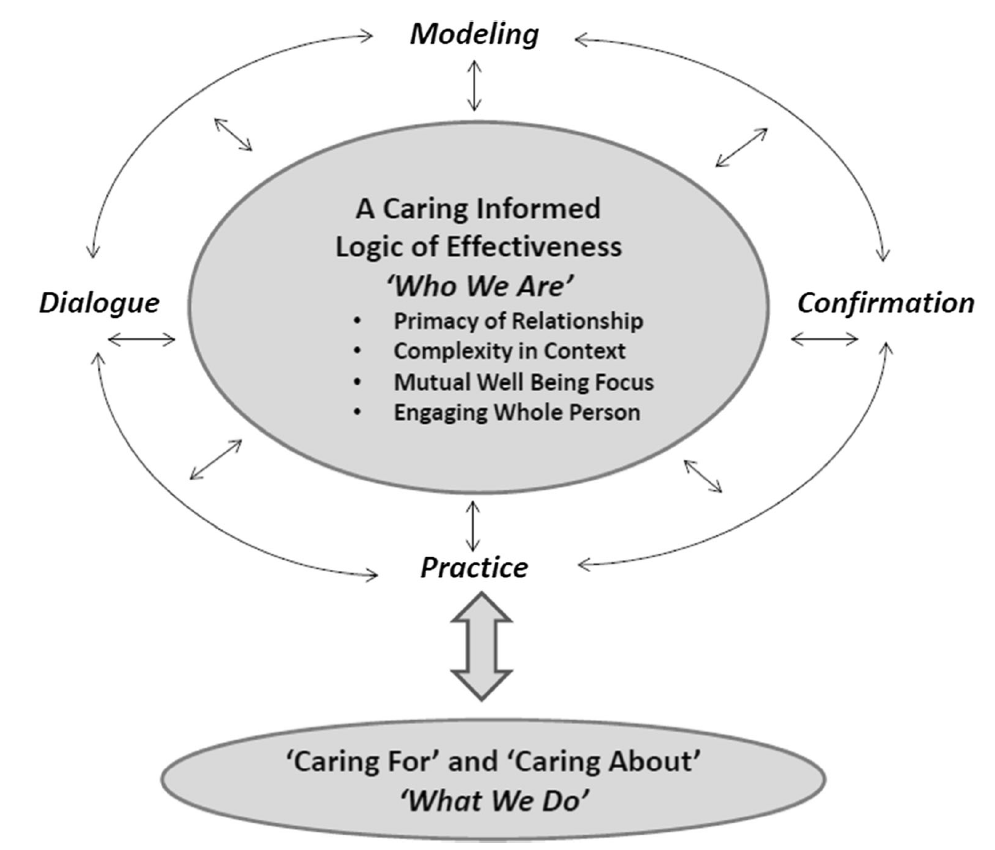
984. Sustainability of AI Societies (Lucivero and Samuel)

985. Minimising Ecosystem Services Tradeoffs (Le 2023)
The analytical framework for minimizing ES trade-offs and maximizing positive ES synergies (E) from the relationships with the ES types (A), demand types (B), drivers (C) and approaches (D) for the win-win outcomes (F), and sustainability (G). (A) Adapted from MA (2005), Haines-Young and Potschin (2010), TEEB (2010); (B) classified by ES involvement, by human want and need, and by stakeholder (adapted from Wol et al., 2015; Chen et al., 2019, and Zheng et al., 2019, respectively); (C) adapted from Wol et al. (2015), Dade et al. (2019); (D) classified by governance type, by direct and indirect driver (adapted from Sattler et al., 2018; Zheng et al., 2019, respectively) and by other [e.g., Two-Eyed-Seeing (Buxton et al., 2021), Actor-Network theory (Ernstson, 2013), transdisciplinary research (TDR) (Quintas-Soriano et al., 2018; Auerswald et al., 2019; Aryal et al., 2022), etc.]; (E) adapted from TEEB (2010), Cohen-shacham et al. (2019); (F) adapted from Zheng et al. (2019); (G) adapted from Wu (2013).

986. 40 ways (Elrick 2019)
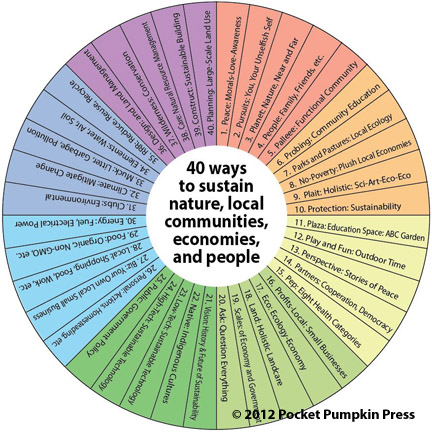
987. Healing for Stolen Generations (Muru Marri, Blignaught 2015)

988. Synergies and Challenges in Holistic Sustainability (Gasso 2023)
(I wonder if the problem might be related to starting with separate pillars as roots leading to a tree of three parts?)

989. Forgetting and Remembering the Once and Future World (Wyndam and Peters 2015 via HE Kucha website, not person).
A partial depiction of the leading role of the guild of biophysical remembrancers, intermittently supported by state-government institutions, issuing warnings of imminent ecological danger. In parallel, the ratcheted demographic-economic business-growth subsystem generates a more powerful array of information and propaganda barraging the individual consumer as a temporary (mortal) citizen of the planet earth. Information flows are indicated by the wavy lines and propaganda by the looping flow lines. The Ratchet is depicted to the left of the Growth gear. ‘Remembrancers’ (1455 CE, Oxford English Dictionary) are officials having the duty of bringing matters to the attention of the proper authorities; one who reminds. Here we broaden the concept to include rememberers, truth-sayers, and foreseers.
This Figure is the central panel of a conceptual model of shifting baselines of ecomyopia and social amnesia in the Anthropocene (Wyndham and Peters, ms 2015). This third instalment in the Ecomyopia Meets the Longue Durée Project continues the development of human ecosystems critical theory for New World industrial societies from an American anthropological perspective. The emphasis in this project is on the information ecology of human ecosystems.

990. Rappaport’s Cybernetic system of the Tsembaga Maring of New Guinea (1969, via HE Kucha website)
Rappaport’s functional model of a Tsembaga Maring ecosystem is the first known diagrammatic attempt at integrating supernatural beliefs and cycles of ritual practice with `local ecosystemic processes.’ His depiction is of a cybernetic system in which beliefs and ritual practices regulate the relative abundance of pigs, social harmony and ultimately, human population. Rappaport separates system components into horizontal panels. Each panel portrays a domain that is a critical part of larger interrelations between the spirit world, the practiced ritual cycle, extra-community relations and biological constraints and affordances. In the top panel, `The Spirit World,’ Smoke Woman mediates between the living, the dead, and other influential spirits in the system, effectively guiding the Maring (through their shamans) in a proscribed but delicate cycle of segregation and integration. Red Spirits (strong, dry, hot) exist in dialectical opposition to the Spirits of Rot (fertile, moist, deathly). Both harbor members who were once living Maring and are involved in Maring affairs at various levels. The management of these complex spirit relationships is accomplished through the processes delineated in the middle two panels which in turn are intrinsically related to the bottom panel of local subsistence processes. In `The Ritual Cycle’ panel, a simplified outline of the Maring ritual cycle is given, showing the (supernatural) obligations incurred in daily living (triggers, `T’) and the rituals (`R’) that satisfy them (taboo, pig sacrifice, planting of rumbim, etc.). The cycle starts over with the rituals that signify the end of a year-long festival, after which taboos are lifted and maximum integration is achieved both in the Spirit World and in the local social system. The next panel, `Inter-Group Relations,’ depicts social events such as inter-group homicide and warfare, truces and festivals. Throughout the ritual cycle, pigs are killed. This effectively regulates the local pig population (bottom panel, `Local Subsistence’), which reduces garden invasions and labor obligations (primarily for women). This model can be seen as a benchmark in the move towards synthesis of the major components of human ecosystems. It integrates cybernetic systems principles with the humanistic and informational depictions of socio-cultural-spiritual systems.

991. Sustainable Inclusive Development in Africa (Emyimba 2019)

992. Modelling Nature Futures (Kim 2023)
(O ra well-set spinnaker despite the tangled sheets).

993. Modelling Nature Futures (Kim 2023)
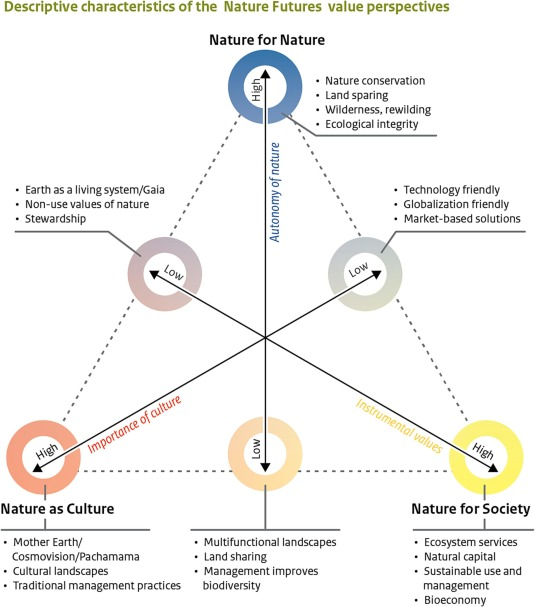
994. Nature Futures Framework (Kim 2023)

995. Technology and ideology (Kozinets 2008, colour version)

996. Coupled systems (Pörtner 2023)

997. Sketchnoted SFG action (Marsha Dunn via UN 2023)

998. Pillars, SDGs and Peace (Haghighi 2024)

998. Institutionalisation of Positive Peace (Haghighi 2024)

1000. Boom. Nature Futures Framework (IPBES Decision 9/1 2022)
The nature futures framework presents three value perspectives of nature in a triangle. In the “nature for nature” perspective, people view nature as having intrinsic value, and value is placed on the diversity of species, habitats, ecosystems and processes that form the natural world, and on nature’s ability to function autonomously. The “nature as culture”/“one with nature” perspective primarily highlights relational values of nature, where societies, cultures, traditions and faiths are intertwined with nature in shaping diverse biocultural landscapes. The “nature for society” perspective highlights the utilitarian benefits and instrumental values that nature provides to people and societies. The coloured circles associated with each value perspective blend together where they intersect, indicating that they are not mutually exclusive. The specific value perspectives that define the corners of the triangular representation of nature futures emerged through numerous stakeholder consultations with a focus on providing a framework for scenario development. According to other knowledge systems and world-views, as portrayed in the right-hand part of the figure, human-nature relationships may be perceived in different ways. The examples in the right-hand part of the figure are taken from the IPBES conceptual framework but are not an exhaustive list of knowledge systems and world-views. The bands and dots indicate that the right-hand part of the figure and the left-hand part of the figure are intimately related, but in complex ways that cannot be described in a one-to-one relationship.

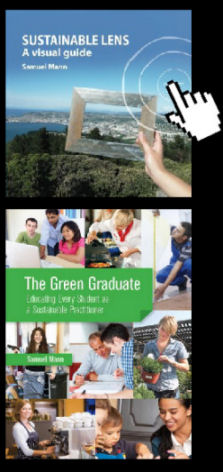
Posted on January 27, 2024
0